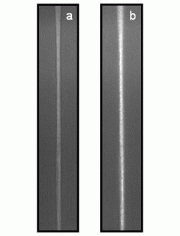July 29, 2008 feature
Physicists Explain Why Liquid Optical Fibers Don't Collapse

(PhysOrg.com) -- For several years, physicists have known that liquid columns can be used to guide light. By trapping a light beam, a liquid column can act like an optical fiber, but with a liquid sheathing instead of glass or plastic.
However, guiding light with liquid fibers has been a great challenge for scientists due to the difficulty of creating stable liquid columns. Liquid columns reach a fundamental limitation called the Rayleigh-Plateau instability which says that, in weightless conditions, a liquid column breaks when its length exceeds its circumference.
Now, a team of physicists, Etienne Brasselet, Régis Wunenburger, and Jean-Pierre Delville, from the University of Bordeaux in France, has developed a model to explain how a liquid column of large aspect ratio can be stabilized by light radiation pressure. The physicists demonstrated how the characteristics of a liquid optical fiber can be tuned at will, opening the doors to the further development of stable liquid optical fibers and their applications.
In 2004, Delville was part of a team that discovered that light radiation pressure has the unique ability to stabilize liquid columns and overcome the Rayleigh-Plateau limit. Further, their technique enabled the liquid columns to self-adapt to the laser that was used to form them, self-tuning their diameter and adjusting their bending angle.
However, no one knew the mechanism behind this stabilizing technique, until now. In a recent issue of Physical Review Letters, the University of Bordeaux physicists explain liquid column stability by a balance between the radiation pressure, which tends to expand a cylindrical column outwards, and the inward constricting interface stresses exerted by the Laplace pressure. Based on their model, the researchers could generate liquid optical fibers with aspect ratios of up to 100 (fibers whose lengths were 100 times greater than their diameters).
“Strictly speaking, here is the main idea,” Delville told PhysOrg.com. “Squeeze a drop of water between the thumb and the index finger, and then move the two fingers away from each other. The drop takes the form of a small liquid fiber. Stretch still a little more and this fiber breaks in two daughter drops under the influence of surface stresses in order to minimize the energy associated with the increase in water-air surface due to stretching. That is why liquid fibers are so difficult to stabilize.
“Conversely, if light is propagated in the fiber, then the electromagnetic field exerts a pressure on its circumference, commonly called pressure of radiation, which works against surface stresses (the so-called Laplace pressure). Beyond some threshold in irradiance, radiation pressure overcomes the Laplace pressure. The liquid fiber is thus stabilized by the guided light and its radius is determined by the balance between pressure of radiation and Laplace pressure. Thus not only the liquid fiber is stabilized by the light, but its radius self-adapts spontaneously to the beam intensity.
“The radius and the length of induced fibers being respectively micrometric and millimetric, these results allow us to advance a microfluidic approach of self-adapted optical guiding while proposing an original answer to the stabilization of liquid columns, a problem studied for the first time by Rayleigh more than one hundred years ago.”
In their demonstration, the researchers used a near-critical phase-separated liquid mixture. They focused an argon ion laser beam down into the cell containing the liquid mixture, which was kept above a critical temperature of 35ºC (95ºF) to achieve a low interfacial tension of the meniscus separating the two coexisting fluid phases.
When the beam had a high enough power (at least hundreds of milliwatts), and was aimed directly at the interface from the fluid phase of the largest index of refraction, the interface became unstable and formed into a liquid column, stable and perfectly guiding the exciting beam.
The physicists explained that the liquid optical fiber strongly depended on the beam power, among other things. For instance, by adjusting the beam diameter inside the liquid, the scientists showed how the liquid optical fiber would change its properties to avoid collapsing. For example, when the beam “waist” (the narrowest part of the beam) is large, the liquid column’s diameter becomes varied across its length. Having different diameter values at a single time makes the system “multistable.”
By understanding the underlying mechanisms of liquid optical fiber stability, the scientists hope their work will lead to the development of reconfigurable light-guiding applications, microdevices with fluid interfaces, and other optofluidics technologies, since droplet microfluidics always involves low interfacial tensions between oil and water by adding surfactants.
More information: Brasselet, Etienne; Wunenburger, Régis; and Delville, Jean-Pierre. “Liquid Optical Fibers with a Multistable Core Actuated by Light Radiation Pressure.” Physical Review Letters 101, 014501 (2008).
Copyright 2008 PhysOrg.com.
All rights reserved. This material may not be published, broadcast, rewritten or redistributed in whole or part without the express written permission of PhysOrg.com.





















